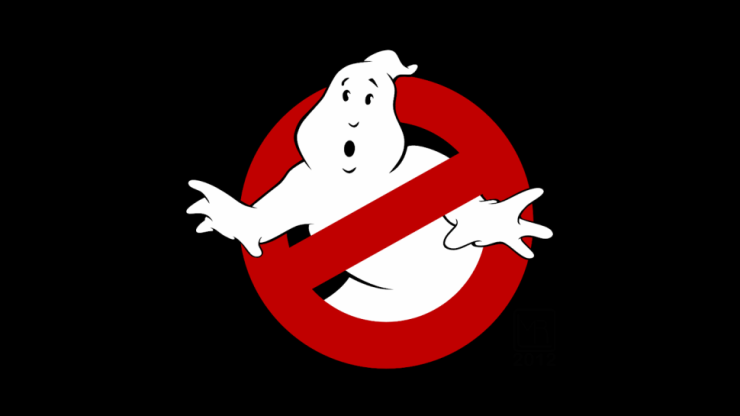Hello! Welcome back to the Movie Rewatch of Great Nostalgia!
Today’s MRGN has a special treat for you—two, TWO movies for the price of one! Ha, ha, ha! Owing to the impending release of a certain sort-of reboot to the franchise, today we’ll be covering that utter classic, Ghostbusters, and its slightly less-than-classic followup, Ghostbusters II.
Please note that as with all films covered on the Nostalgia Rewatch, this post will be rife with spoilers for both films. So be good, for goodness’ sake!
ME: So let’s talk about Ghostbusters.
LIZ: Dogs and cats, living together!
ME: Ha ha, yes.
KATE: Listen! You smell something?
ME: Heh, right. But—
LIZ: Aim for the flattop!
KATE: And the flowers are still standing!
LIZ: I looked at the trap, Ray!
KATE: Ray, if someone asks you if you’re a god—
LIZ & KATE: You—say—YES!
ME: Okay! Yes, we know, it is a very quotable film. But what do we think about the movie? Like, overall?
[silence]
LIZ: Um. It’s… it’s Ghostbusters.
KATE: Yeah. I mean—Ghostbusters.
ME: Oh boy.
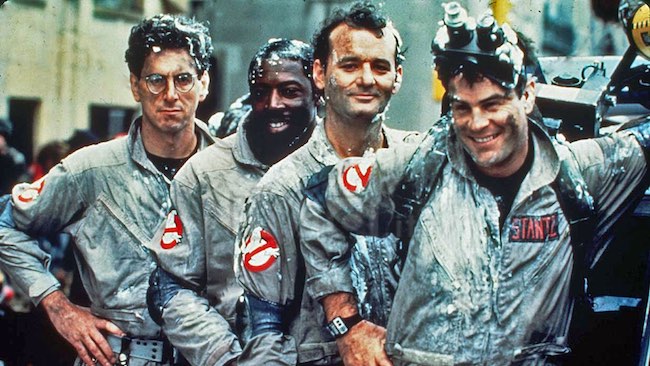
Yeah, so it turns out the problem with talking about (or writing about) Ghostbusters is that it is that most vanishingly rare phenomenon in Hollywood: the near-perfect movie. Plot, character, dialogue, production design, setting, cast, soundtrack—just about every last element of this movie is—whether by accident or not—almost flawlessly executed, and in wonderful harmony with each other. The only area, in my opinion, that you could possibly ding it for is the special effects, but even the cheesiness of the effects suits the overall tone, and in general is completely forgivable by virtue of the awesomeness of everything else. (Warning: do not click that link if you need to get anything done today.)
In terms of achieving what it set out to accomplish, at least as far as I am concerned, Ghostbusters is that perfect storm that nearly every film aspires to be, and almost none of them actually are.
But this also means that it is sort of difficult to figure out how to approach a critique of it—or even a silly nostalgia blog post about it. Flawlessness is also frictionlessness, so it took me a while to figure out how to get a grip on it, so to speak.
And I don’t think this is just nostalgia talking, either. Certainly Ghostbusters possesses an indelible and ubiquitous place in my childhood movie memories, right up there with Star Wars and the Indiana Jones franchise, and maybe the fact that I have seen it so many times I could practically quote it from memory interferes with my objectivity, but that in itself is more of an argument for its excellence than it is anything else.
I am hardly alone in feeling that way. Ghostbusters was a sensation when it came out in 1984, and it has not stopped being one in the ensuing 30+ years. For proof I need look no further than my own five-year-old nephew, who had played with Lego Ghostbusters (both actual Lego and the video game version), made us play the Ghostbusters theme on repeat, and declared his intention to be a Ghostbuster when he grew up, all well before marketing for the 2016 reboot even got underway. (Indeed, Remy’s obsession with the franchise started well before he was allowed to watch the actual original movie, which is kind of hilarious. One of these days Remy is going to find out that there was a cartoon series too, and he will lose his mind. Heh.)
Which is awesome, but not particularly surprising. Ghostbusters has become a fundamental part of our pop culture landscape, and I will not be surprised if Remy’s own children end up playing with whatever the future version of Lego Ghostbusters will be. (Probably Lego Ghostbusters, honestly. Speaking of indelible pop culture phenomenons…)
Granted, a thing doesn’t have to be perfect or even good to be a pop culture sensation (a certain sparkly franchise comes to mind), but Ghostbusters is a step above because it works on so many more levels than just a quirky premise, a cool logo and a snappy catchphrase. Beyond just being a cool, fun (and unusually original) SF movie, it’s also arguably one of the best comedies made in the last fifty years, and is generally considered to be one of the quintessential New York City movies to boot.

Having lived in New York myself for a few years (even if that was two decades later than the New York that Ghostbusters depicts), I agree even more now than I did when… er, well, when this movie was one of the things forming my basic impression of what New York was like in the first place. So that might be a kind of chicken or the egg type situation. But I don’t think I’m wrong, because the city is itself one of the most important characters in the movie—arguably, the most important. The movie literally could not have been set anywhere else and still have worked.
And actually, you can see how Ghostbusters got New York so very right just by comparing it to how its sequel, somehow, didn’t get New York right at all. Or most anything else, either, but we’ll come back to that.
The first movie managed to capture New York perfectly, probably because it just showed it, with loving, exasperated affection for both its virtues and its foibles, without feeling the need to say to the audience, “Hey! Here are New York’s virtues and foibles, in a bulleted list!”
Whereas Ghostbusters II tried to tell us what New York was, in trite, didactic, vaguely insulting terms, and therefore failed miserably. Ghostbusters II, in fact, came off like it was made by someone who had only read or watched movies about New York, instead of by someone who’d actually lived there. Which is profoundly weird, considering the exact same people (Ivan Reitman, Harold Ramis, and Dan Aykroyd) wrote and directed both movies.
The only thing I can figure, really, is that the sequel fell prey to what sequels so often do: meddling from the suits upstairs. When the first movie was being made, I strongly suspect no one on the executive level gave much of a shit about it, probably because everyone thought it was going to be an utter flop anyway, and so they left the creative folk in peace to do their thing. But of course it was a completely different situation when it came to making a followup to a global box office smash. And, as has happened so many times in Hollywood, the pressure and expectation and interference from above on the sequel ultimately crushed the life out of it. Or so I theorize.
It failed on a lot more than just faux New Yorkness, too. The plot was absurd, for one. I mean, the first movie’s plot was absurd, too, but it was absurd in a way that made me laugh cheerfully at it, while the sequel’s plot was just eye-rollingly ridiculous. For another, other than Jackie Wilson’s “Higher and Higher”, the soundtrack was wretched, pandering, and instantly dated, where the original’s is iconic. (Yes, Ray Parker, Jr.’s theme is about the most 80s thing ever made, but in a way that makes it classic instead of dated, pretty much from the moment it came out.) And furthermore, with a few exceptions, the dialogue in the sequel feels limp and dull, where the original is one of the most quotable movies ever made. And while the special effects of both movies are awful in spots, the sequel’s managed to be worse overall, despite having twice the budget and five years’ worth of technological advancements on the original. I mean, how do you even do that?
Worst of all the sequel’s sins for me, of course, is its treatment of Sigourney Weaver’s character Dana Barrett. While in the original movie, admittedly, she is creeped upon by Rick Moranis’s Louis Tully (and, arguably, Peter Venkman), and additionally put in the position of being a damsel in distress for her love interest to rescue, she is put there in possibly the most awesomely unique (and hilarious) fashion ever, in a way that allowed both the character and the actress to shine. It’s hard to define, but Dana in the original Ghostbusters had an agency and strength of personality that many damseled and/or objectified female characters are not allowed. In other words, the original movie is never going to win any awards for progressive attitudes toward women, but at least its latent sexism was leavened with humor and a certain amount of weird respect.
(Sister Kate would like to interject here that while she generally agrees, nevertheless she has mad respect for the crazy slinky flame dress Possessed Dana lounges around in:
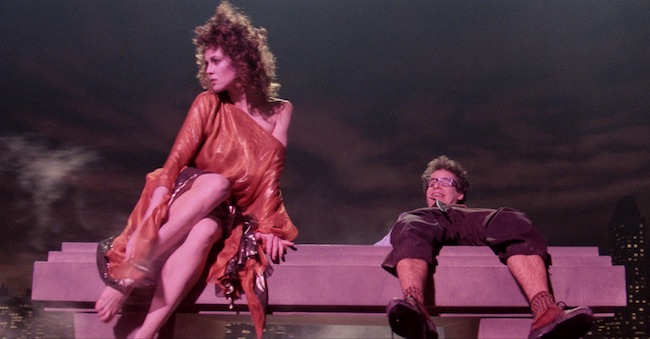
She thinks it looks like something that should have won top prize at Project Runway; I’m pretty sure she means that as a compliment. Sister Liz adds her mad respect for Sigourney Weaver in somehow managing not to give us a panty shot in that dress no matter how she sprawled and slid around in it, which I have to admit was damn impressive.)
In the sequel, on the other hand, Dana is just as objectified and damseled as she is in the first movie, but with none of the upsides, and with the added insult of leaving her virtually nothing to do in between but be victimized by proxy via her baby. Dana in Ghostbusters II was the triple threat of female stereotypes (distressed damsel, shrieking mother, and boring love interest) as well as a total waste of a Sigourney Weaver, and it was a real bummer.
(In line with my general strenuously upheld policy of avoiding spoilers beforehand, I actually know next to nothing about the 2016 reboot—and would appreciate keeping it that way, thank you. But given what I’ve said above, I am extremely interested to see how a gender-flipped Ghostbusters will work. The possible pitfalls are plentiful, but I am perfectly prepared to be pleased!)
The sequel’s only saving grace, really, was Bill Murray, who has a nearly superhuman ability to make literally anything funny just by existing near it, as far as I can tell. It’s positively uncanny. Needless to say, just about every genuine laugh I got out of the sequel, especially this time around, was because of him.
And, okay, the toaster made me laugh too:
But that was mostly because of Murray, too. Really, anytime it was the cast just screwing around (or Bill Murray saying words, or having an expression) it was pretty fun. But it’s really not a good sign that anytime actual plot was happening, my interest in the movie instantly plummeted to zero.
I should mention that Sister Kate, in particular, has a lot of affection for Ghostbusters II and thinks I am being way too harsh on it. But, she admits, as the youngest of us she was in a much more forgiving age bracket when the sequel came out in 1989 than either Liz or myself. Nephew Remy, on being asked (as a sort of neutral party) which of the two he liked better, answered rather confusingly that he liked “the one that was funnier”, but then brought up the Stay Puft Marshmallow Man (“he is my favorite person made out of marshmallows”).
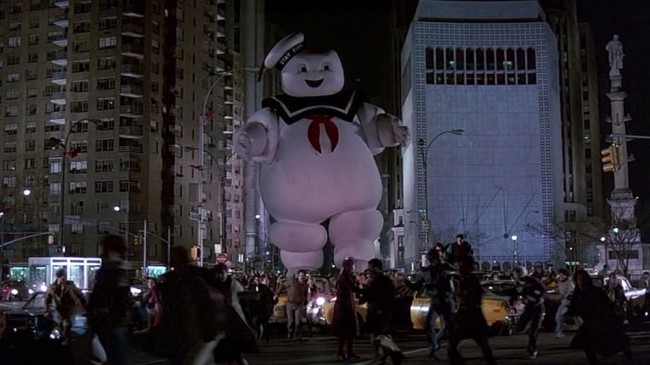
So I contend that Remy is on my side, and you should pay no attention to that sibling rolling her eyes at me for shielding myself behind a five-year-old.
But enough about the inferior sequel; let’s talk about the awesome first movie, and thoughts me and my sisters had about some specific bits of it!
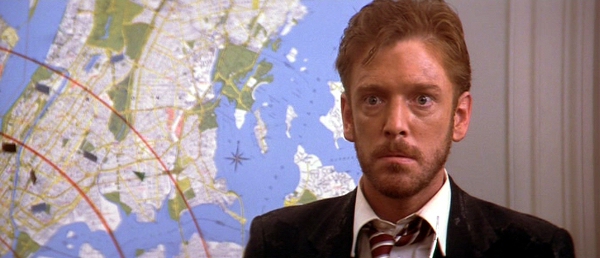
LIZ: Ha ha, his name is Walter Peck.
KATE: And unlike Willow, he actually deserves the name.
ME: Peckless!
(It’s sort of hilarious, though, that the EPA, an organization dedicated to, basically, keeping us from polluting our planet to death, is the villain of the movie, when in fact everything Peck says to Venkman, once stripped of William Atherton’s consummate asshole portrayal abilities, consists of actually completely valid concerns. I mean, these are random dudes running around one of the larger metropolises in the world merrily causing enormous amounts of property damage with radioactive backpacks and utterly unvetted containment procedures for, well, effin’ ghosts. The EPA should be deeply alarmed about their business, and they probably actually should have been shut down. But, hey.)
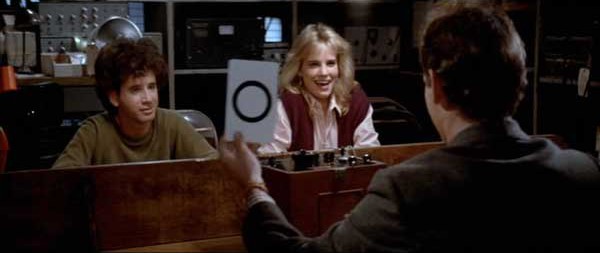
Fun fact: Venkman’s “psychic” experiment at the beginning is based on a real experiment. Except that the actual point of the experiment was not to see whether people really had ESP, but on how far people were prepared to allow authority figures to treat them (or others) badly. As far as the movie is concerned, it seems to be more of a test of how far Bill Murray’s personal charisma extends before his character becomes irredeemably unlikeable. (Verdict: rather disturbingly far.)
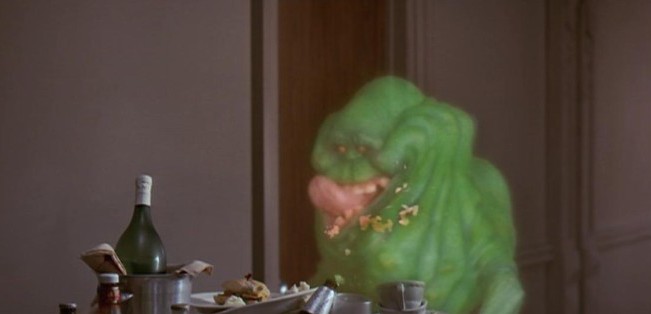
My sisters and I debated whether we should be bothered that no one, in either movie, ever brings up the issue of the morality of trapping what we have to assume are people’s souls. Even though most of the “ghosts” don’t look anything like human; like, what is Slimer supposed to be? Apparently Dan Aykroyd joked that he was the ghost of John Belushi, which is the kind of joke only a close friend can make, but there is a definite effort to detach our perception of the ghosts Our Heroes hunt and trap, from the human beings they presumably used to be. I mean, there’s only so seriously you can take this question in the context of an obviously comedic movie, but, well, we’re geeks. These are the things we think about.
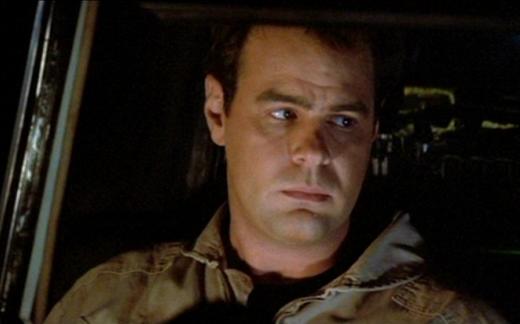
“I remember Revelations 7:12: ‘And I looked, and he opened the sixth seal, and behold, there was a great earthquake. And the sun became as black as sack cloth, and the moon became as blood.’”
I didn’t so much get this back in the day, but nowadays I love that Ray is an atheist who can quote the Bible verbatim, which basically makes him like every atheist I’ve ever known. I’m just saying, don’t get into a theological argument with an atheist unless you’re prepared to bring the knowledge, people. They know more about your religion than you do. Heh.

LIZ: No, really, what is with this costume? It looks like diseased cellophane.
KATE: The built-in kitten heels were a nice touch, though.
In other news, it’s worth noting that this movie was the reason I became aware of the practice called pan and scan, because that’s the reason why the “media montage” scene of Ghostbusters was ruined when shown on TV back in the day, because the selective cropping meant that the (awesome) fake magazine covers were inevitably cropped out:
You young miscreants should be grateful that you don’t have to deal with fuckin’ 16:9 to 4:3 conversions anymore, is all I’m saying. Back in MY day, we had to climb uphill to watch movies! Both ways! In the snow! Or something!
And really, this could go on and on, because there is hardly a moment in the original Ghostbusters that isn’t worthy of note, but this has got to stop somewhere, so I’m picking here. In sum, the sequel may not have been all that, but the original film was and is one of the greats in the annals of SF movie history, or indeed in movie history, period, and I do not envy the makers of the 2016 reboot the task of following in its footsteps. We shall see what happens; certainly the folks at Tor.com are primed and ready to cover every last aspect of it, so stay tuned!
But for me, this is where we stop, so I will wrap up, as I ever shall, with my Nostalgia Love to Reality Love 1-10 Scale of Awesomeness!
For Ghostbusters:
Nostalgia: 10
Reality: 10
For Ghostbusters II:
Nostalgia: 5
Reality: 4
Here ends the post, but now it’s on you! Tell me your thoughts! And then come back in two weeks, when the MRGN resumes with a rather more traditional science fiction classic: Starman! Whoo! See you then!










